- Administrator
- Albums and Singles
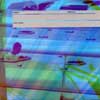 It's hard to describe the sort of movements that music evolve towithout giving it a genre name that gets used, then overused, thencompletely hated and rejected only a couple years later. I do like whatI'm hearing, however, a LOT. Trapist are the latest in a line oftalented collective players who integrate some of the elements thehigh-brow fashionable snotty music press faves have introduced over thelast couple years (software, electronic reprocessing) with honedplaying skills that can lend to collective improvisational pieces, andheavy tendencies towards actual song structure (yes, it's nice not tohear "jazz" fans noodling around with no goal). On Ballroom,the Viennese trio's first studio record, all elements come togethergracefully for an amazing listen. The trio consists of MartinBrandlmayr, Martin Siewart, and Joe Williamson: names which haveappeared in Radian, and alongside people like Christian Fennesz, DeanRoberts and Werner Dafeldecker, Stefan Schneider, Ken Vandermark, KevinDrumm, and plenty more. Comparisons will no doubt be drawn to thesparse guitar work of quieter Tortoise and Angelo Badalamenti andgroups like Nudge and latter-day Talk Talk, but Trapist tend to explorethings a bit deeper, with songs that stretch well past the 15 minutemark as opposed to collecting between eight and ten 3-5 minute tunes.Songs often open with light brushed drum sounds, double bass andguitar, but are soon joined with unobtrusive keyboards, subtleelectronic effects, percussion, and rhythmic noise. While Ballroomis already one of my most frequently played albums of the young year,it's not hard to wonder if this stuff will catch on. Bands and criticsmay complain about the post-rock pigeonholing but it did provide somesort of attention and leverage to a lot of groups' budding careers. Ifthis stuff never catches on, it'll be difficult for a number of reallygreat groups to book shows, get out of their remote areas (Dean Robertsis in Australia, Nudge is in Oregon) and help evolve music to the nextlevel.
It's hard to describe the sort of movements that music evolve towithout giving it a genre name that gets used, then overused, thencompletely hated and rejected only a couple years later. I do like whatI'm hearing, however, a LOT. Trapist are the latest in a line oftalented collective players who integrate some of the elements thehigh-brow fashionable snotty music press faves have introduced over thelast couple years (software, electronic reprocessing) with honedplaying skills that can lend to collective improvisational pieces, andheavy tendencies towards actual song structure (yes, it's nice not tohear "jazz" fans noodling around with no goal). On Ballroom,the Viennese trio's first studio record, all elements come togethergracefully for an amazing listen. The trio consists of MartinBrandlmayr, Martin Siewart, and Joe Williamson: names which haveappeared in Radian, and alongside people like Christian Fennesz, DeanRoberts and Werner Dafeldecker, Stefan Schneider, Ken Vandermark, KevinDrumm, and plenty more. Comparisons will no doubt be drawn to thesparse guitar work of quieter Tortoise and Angelo Badalamenti andgroups like Nudge and latter-day Talk Talk, but Trapist tend to explorethings a bit deeper, with songs that stretch well past the 15 minutemark as opposed to collecting between eight and ten 3-5 minute tunes.Songs often open with light brushed drum sounds, double bass andguitar, but are soon joined with unobtrusive keyboards, subtleelectronic effects, percussion, and rhythmic noise. While Ballroomis already one of my most frequently played albums of the young year,it's not hard to wonder if this stuff will catch on. Bands and criticsmay complain about the post-rock pigeonholing but it did provide somesort of attention and leverage to a lot of groups' budding careers. Ifthis stuff never catches on, it'll be difficult for a number of reallygreat groups to book shows, get out of their remote areas (Dean Robertsis in Australia, Nudge is in Oregon) and help evolve music to the nextlevel.samples:
Read More
- Administrator
- Albums and Singles
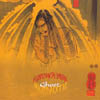 The last few years have seen popular movements in the development ofimprovisational rock music, whether it's influenced by Anglo folk,experimental, or jazz music. There's another dimension, however, whichin my mind takes the music up a notch: the psychedelic/prog bit. Byincorporating the colorful drug-crazed lunacies of a few decades' past,Ghost have been pleasing very devoted international crowds for years,and it's no wonder, their songs are true songs and not just a bunch ofpeople farting around who can barely play their instruments. Hypnotic Underworldis easily one of 2004's first fantastic albums of the year, with thefamiliar genre-bending stretches of Ghost and shimmering over-the-topproduction by Taishi Takizawa. It opens with a stunning four-partmovement of "Hypnotic Underworld," and the slow building 13.5 minute"God Took a Picture of His Illness On This Ground." Here, a commandingbassline underscores saxophone, malleted drums, echoes and twitters ofsound effects, all contributing to an experience remeniscent of masterslike Taj Mahal Travelers and Magical Power Mako, siezing control of thesenses, disallowing much else to be paid attention to, other than themusic. Part two, "Escaped and Lost Down in Medina" picks up the pacewith a steady beat, a sea of other instruments (including prominentdrums, guitar, strings and piano), and a mesmerizing looped basslinethat doesn't change for the entire 7+ minutes. It acts as a perfectcrescendo on to the rest of the album as the buildup of sound andtension increases steadily through pretty much every cycle of the bassloop. The choral vocals of part three, "Aramaic Barbarous Dawn" ache tobe dragged out much longer than the 2+ minutes and scream of late 1960sacid-induced psychedelia before it quickly runs right into the22-second part four. From here on, the album picks up with variousstyles of rock, jazz, and sound textures, toying with pop tendenciesnearly all the time with instruments remeniscent of experimental pop ofyesteryear. Organ, harpsichord, tabla, sitar, and flute aren'tuncommonly found alongside squealy guitar solos and trancelike vocals.Whether the music conjures up images of babbling brooks and folkloreforests, staring endlessly into a clear starry night, the hellfire ofthe underworld, or completely dazed black light parties, the songs on Hypnotic Underworldare never weak or loosely strung along, and the album seemssurprisingly short at 70+ minutes. While I look forward to seeing themlive, I'd much rather be sitting on the grass outside rather than bestuck in a dirty rock club with an obnoxious cash machine jingling offin the distance.
The last few years have seen popular movements in the development ofimprovisational rock music, whether it's influenced by Anglo folk,experimental, or jazz music. There's another dimension, however, whichin my mind takes the music up a notch: the psychedelic/prog bit. Byincorporating the colorful drug-crazed lunacies of a few decades' past,Ghost have been pleasing very devoted international crowds for years,and it's no wonder, their songs are true songs and not just a bunch ofpeople farting around who can barely play their instruments. Hypnotic Underworldis easily one of 2004's first fantastic albums of the year, with thefamiliar genre-bending stretches of Ghost and shimmering over-the-topproduction by Taishi Takizawa. It opens with a stunning four-partmovement of "Hypnotic Underworld," and the slow building 13.5 minute"God Took a Picture of His Illness On This Ground." Here, a commandingbassline underscores saxophone, malleted drums, echoes and twitters ofsound effects, all contributing to an experience remeniscent of masterslike Taj Mahal Travelers and Magical Power Mako, siezing control of thesenses, disallowing much else to be paid attention to, other than themusic. Part two, "Escaped and Lost Down in Medina" picks up the pacewith a steady beat, a sea of other instruments (including prominentdrums, guitar, strings and piano), and a mesmerizing looped basslinethat doesn't change for the entire 7+ minutes. It acts as a perfectcrescendo on to the rest of the album as the buildup of sound andtension increases steadily through pretty much every cycle of the bassloop. The choral vocals of part three, "Aramaic Barbarous Dawn" ache tobe dragged out much longer than the 2+ minutes and scream of late 1960sacid-induced psychedelia before it quickly runs right into the22-second part four. From here on, the album picks up with variousstyles of rock, jazz, and sound textures, toying with pop tendenciesnearly all the time with instruments remeniscent of experimental pop ofyesteryear. Organ, harpsichord, tabla, sitar, and flute aren'tuncommonly found alongside squealy guitar solos and trancelike vocals.Whether the music conjures up images of babbling brooks and folkloreforests, staring endlessly into a clear starry night, the hellfire ofthe underworld, or completely dazed black light parties, the songs on Hypnotic Underworldare never weak or loosely strung along, and the album seemssurprisingly short at 70+ minutes. While I look forward to seeing themlive, I'd much rather be sitting on the grass outside rather than bestuck in a dirty rock club with an obnoxious cash machine jingling offin the distance.samples:
Read More
- Administrator
- Albums and Singles
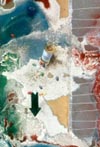 Massachusetts-based Sedimental Records has been in sporadic activitysince 1993. They don't put out records often, but when they do it'sclearly a labor of love. Past releases skip across what is either ahighly idiosyncratic or just plain broadminded survey of experimentalmusics, revealing a commendable focus on debut and early releases fromrelatively obscure artists. The packaging and presentation of thelabel's releases are consistently exceptional, though they operate bestas indicators of the keen interest and investment Sedimental brings tothe music itself. Late 2003 saw the release of five new titles, endinga period of stagnancy with quite a bang. The first of these comes fromTexas improvisers Tonalamotl, a revolving group of musicians who createslow-building textural immersions much in the traditional ofelectro-acoustic groups like AMM. All tracks were recorded live aroundthe surprisingly rock-ist core instrumentation of guitars and drums.These instruments become hardly recognizable, the guitars taking onthrobbing, motor-like sounds that ride the background much of the timeand drums sounding systematically disassembled, each piece of wood andmetal given its proper tinkering. The most interesting aspect ofTonalamotl's music is the way the group seems to confront theperformance space. Much of the sound on Mo(ve)mentsumfeels gathered via contact mics, scraping surfaces or mining the airaround the diligent performers, who move with the frenzied attention ofelectrons in an atomic cage. In a track performed at Austin's 33?Records, the store's door alarms, scattered coughs and floor creaksbecome lynch pins and transition markers in the drifting composition.Hundreds of sounds incapable of being passed off on keyboard or evendog whistle (both of which appear liberally) make up the bulk of theseoften subtle, though immediate pieces. Wind coming through the room onone track sounds like it could've been pulled from Alan Splet'sambient-industrial Eraserhead soundtrack; elsewhere what mustbe a keyboard drone meets distant percussive hammering to approximatethe sound of an idling engine, punctuated by the occasional cymbalcrash or drum kick. Moments like these abound, where splashes of therecognizable or the rough bring the listener out of the budding trancestate, face-to-face with the twitching human making all the racket. Theproduction is such that each exploited detail is respectfully capturedbut in a way that allows the rustic character of the music to bleedthrough. Even with this new release, their second, Tonalamotl remainsan enigmatic group, its members involved in various ways with other(unlikely) Texas bands such as At the Drive In, Trail of Dead, andWhite Heat. With the recording dates for these tracks stretching backto '97 and '98, it seems doubtful that the group will record again, allthe more reason to look for Mo(ve)mentsum now.
Massachusetts-based Sedimental Records has been in sporadic activitysince 1993. They don't put out records often, but when they do it'sclearly a labor of love. Past releases skip across what is either ahighly idiosyncratic or just plain broadminded survey of experimentalmusics, revealing a commendable focus on debut and early releases fromrelatively obscure artists. The packaging and presentation of thelabel's releases are consistently exceptional, though they operate bestas indicators of the keen interest and investment Sedimental brings tothe music itself. Late 2003 saw the release of five new titles, endinga period of stagnancy with quite a bang. The first of these comes fromTexas improvisers Tonalamotl, a revolving group of musicians who createslow-building textural immersions much in the traditional ofelectro-acoustic groups like AMM. All tracks were recorded live aroundthe surprisingly rock-ist core instrumentation of guitars and drums.These instruments become hardly recognizable, the guitars taking onthrobbing, motor-like sounds that ride the background much of the timeand drums sounding systematically disassembled, each piece of wood andmetal given its proper tinkering. The most interesting aspect ofTonalamotl's music is the way the group seems to confront theperformance space. Much of the sound on Mo(ve)mentsumfeels gathered via contact mics, scraping surfaces or mining the airaround the diligent performers, who move with the frenzied attention ofelectrons in an atomic cage. In a track performed at Austin's 33?Records, the store's door alarms, scattered coughs and floor creaksbecome lynch pins and transition markers in the drifting composition.Hundreds of sounds incapable of being passed off on keyboard or evendog whistle (both of which appear liberally) make up the bulk of theseoften subtle, though immediate pieces. Wind coming through the room onone track sounds like it could've been pulled from Alan Splet'sambient-industrial Eraserhead soundtrack; elsewhere what mustbe a keyboard drone meets distant percussive hammering to approximatethe sound of an idling engine, punctuated by the occasional cymbalcrash or drum kick. Moments like these abound, where splashes of therecognizable or the rough bring the listener out of the budding trancestate, face-to-face with the twitching human making all the racket. Theproduction is such that each exploited detail is respectfully capturedbut in a way that allows the rustic character of the music to bleedthrough. Even with this new release, their second, Tonalamotl remainsan enigmatic group, its members involved in various ways with other(unlikely) Texas bands such as At the Drive In, Trail of Dead, andWhite Heat. With the recording dates for these tracks stretching backto '97 and '98, it seems doubtful that the group will record again, allthe more reason to look for Mo(ve)mentsum now.samples:
Read More
- Administrator
- Albums and Singles
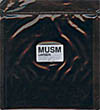 Larsen never lacked a sense of beauty. Even on the most catharticrushes of adrenalin guitar mayhem that erupted at opportune moments ontheir stunning Michael Gira-produced album Rever,they always had an air of ritual mystery and a mystical energy thatperhaps recalled other intense Europeans Deity Guns and Neubauten, witha nod to prime New York avant rock. There are ancient monumentalshadows looming over and cast by their muse. Having lost bassist SilviaGross to jazz, Larsen are now a quartet with a more stripped-down,instrumental sound, which is no doubt going to see them get a fewgodspeed comparisons. Every ringing guitar note and accordian dronehits home in an uplifting spirited enunciation of landscapes bothcinematic and emotional. It's no surprise to discover that they'veplayed gigs supporting Thalia Zedek, who no doubt found them kindredspirits. While on Rever there were occasional jousts of LiveSkull dual guitar hellfire, here, heavy ponderous drums hit home withthe same melancholic deliberation as Come and Thalia's more recent solorecordings. MUSM was originally a very limited US tour CD-R butis now getting a wider release on CD and vinyl. It opens with a collagefrom Larsen's long unavailable debut album, No Arms No Legs: Identification Problems and a couple of remastered tracks from that album which set the scene but are soon surpassed. Half of MUSMwas recorded as a soundtrack to Winsor McCay's animation"Cartoanimalettimatti." These five tracks are certainly rivetingstanding alone, more enticing melodic entanglements unfurling withevery repeat listening, yet it would've been nice to have seen some ofthe animations on the computer section of the CD-R. "How a MosquitoOperates" circles inexorably towards some bloody climax, and "TheSinking of the Lusitania" is suitably aquatic, each dramatic pausebetween chords seeming to let more water seep in. There is anunrecognizably mutated version of Syd Barret's "Vegetable Man," whichopens with an accordian drone elegy, before sleigh bells and guitarpangs rise slowly above creaking turnip brains. A short outtake from arecent rehearsal session ends the album with a hesitant question mark.However the highlight of MUSM might well be the film of Larsenperforming a majestic slow building instrumental in a Polish cathedral,not so much for the film itself which fades images of the band walkingthe glowing night time streets of Gdansk with their static stagepresence, but for the music which would have been nice to have had asregular audio. Maybe this is a hint of even better things to come andwill appear on a future album? Larsen have two more albums in thepipeline, including collaborations with Lustmord and Jarboe. If they'reeven half as fine as this, they'll be utterly essential.
Larsen never lacked a sense of beauty. Even on the most catharticrushes of adrenalin guitar mayhem that erupted at opportune moments ontheir stunning Michael Gira-produced album Rever,they always had an air of ritual mystery and a mystical energy thatperhaps recalled other intense Europeans Deity Guns and Neubauten, witha nod to prime New York avant rock. There are ancient monumentalshadows looming over and cast by their muse. Having lost bassist SilviaGross to jazz, Larsen are now a quartet with a more stripped-down,instrumental sound, which is no doubt going to see them get a fewgodspeed comparisons. Every ringing guitar note and accordian dronehits home in an uplifting spirited enunciation of landscapes bothcinematic and emotional. It's no surprise to discover that they'veplayed gigs supporting Thalia Zedek, who no doubt found them kindredspirits. While on Rever there were occasional jousts of LiveSkull dual guitar hellfire, here, heavy ponderous drums hit home withthe same melancholic deliberation as Come and Thalia's more recent solorecordings. MUSM was originally a very limited US tour CD-R butis now getting a wider release on CD and vinyl. It opens with a collagefrom Larsen's long unavailable debut album, No Arms No Legs: Identification Problems and a couple of remastered tracks from that album which set the scene but are soon surpassed. Half of MUSMwas recorded as a soundtrack to Winsor McCay's animation"Cartoanimalettimatti." These five tracks are certainly rivetingstanding alone, more enticing melodic entanglements unfurling withevery repeat listening, yet it would've been nice to have seen some ofthe animations on the computer section of the CD-R. "How a MosquitoOperates" circles inexorably towards some bloody climax, and "TheSinking of the Lusitania" is suitably aquatic, each dramatic pausebetween chords seeming to let more water seep in. There is anunrecognizably mutated version of Syd Barret's "Vegetable Man," whichopens with an accordian drone elegy, before sleigh bells and guitarpangs rise slowly above creaking turnip brains. A short outtake from arecent rehearsal session ends the album with a hesitant question mark.However the highlight of MUSM might well be the film of Larsenperforming a majestic slow building instrumental in a Polish cathedral,not so much for the film itself which fades images of the band walkingthe glowing night time streets of Gdansk with their static stagepresence, but for the music which would have been nice to have had asregular audio. Maybe this is a hint of even better things to come andwill appear on a future album? Larsen have two more albums in thepipeline, including collaborations with Lustmord and Jarboe. If they'reeven half as fine as this, they'll be utterly essential. samples:
Read More
- Administrator
- Albums and Singles
 The peat bogs of Northern Europe have been the source of some of themost exciting archaeological finds of last century. Fortuitously, thechemical content of these viscous pools of goo was such that corpsesfished out thousands of years later were hardly decomposed at all,allowing anthropologists to solve many a historical riddle of the earlyIron Age. Bog Bodies are currently on display at the Museum of Ireland,stunningly lifelike bronzed cadavers, many fully dressed in the costumeof the period. Earthmonkey is the work of a homo erectus named PeatBog, who has managed a similar archaeological excavation on Audiosapien.Perhaps it is less significant to the scientific community, butEarthmonkey's terrestrial, Neolithic stomp is a deliriously accuratereconstruction of the hairiest psych-prog of 30 years past. This is nota zoo-bound monkey of the poo-throwing variety; this monkey is aholdover from a previous evolutionary phase, a giant ape that boundsacross the fertile landscape on its knuckles looking for sustenance,but finding only amanita muscaria on which to subsist. So thisEarthmonkey vibrates to an ancient shamanistic current, riding the waveof Terrence McKenna's archaic revolution, which Peat Bog translatesinto a series of deep and droning rhythmic jazz-rock jams, liberallysprinkled with moondust by producer Steven Stapleton. This pairingmakes sense, as Peat Bog has collaborated with Nurse With Wound onseveral releases as Inflatable Sideshow, and Stapleton's productiontouches jettison this material straight to the heart of the Kraut. Therhythms on Audiosapien are of the trance-inducing JakiLiebezeit mould, with a variety of lysergically-effected guitar riffs,saxophone blasts and atmospheric electronic textures, unashamedlyevoking mid-period of Amon Duul II or arcane Kosmische jam bands Kraanand Xhol Caravan. This hairy, future-primitive quagmire is augmented bycontemporary beat constructions, which places Earthmonkey vaguely inthe techno-prog neighborhood of The Orb and Eat Static. "Reflections OnNative Yard 52" lifts the bassline from The Rolling Stones' "2000 LightYears From Home," but veers into an entirely different wormhole: acyclical rhythm that perpetually reigns in the cosmic bounce of thelead guitar. Elsewhere, the roll of a didgeridoo creates a droning,ethnicized backdrop for mellow grooves, every empty space filled withghostly vocal samples and bizarre Stapletonian textures. The plot ofthe Lord of the Rings is recounted by a young British lad withsound-effects accompaniment on "'And They Go Off To This Place...,'"and the two-part song suite of "Burningman" attempts to evoke theprimitive desert paganism at the heart of the annual Nevadafestival/rave/catharsis. The deeply stoned third-eye soloing on "MakeMe One With Everything" is so immersive, it makes the goofy song titlealmost completely forgivable. Plumbed from the depths of Ireland'sgelatinous fens, Audiosapien is the sound of psychedeliade-evolving into the shaggy depths of a dimly remembered past. And mostimportantly, it doesn't suck.
The peat bogs of Northern Europe have been the source of some of themost exciting archaeological finds of last century. Fortuitously, thechemical content of these viscous pools of goo was such that corpsesfished out thousands of years later were hardly decomposed at all,allowing anthropologists to solve many a historical riddle of the earlyIron Age. Bog Bodies are currently on display at the Museum of Ireland,stunningly lifelike bronzed cadavers, many fully dressed in the costumeof the period. Earthmonkey is the work of a homo erectus named PeatBog, who has managed a similar archaeological excavation on Audiosapien.Perhaps it is less significant to the scientific community, butEarthmonkey's terrestrial, Neolithic stomp is a deliriously accuratereconstruction of the hairiest psych-prog of 30 years past. This is nota zoo-bound monkey of the poo-throwing variety; this monkey is aholdover from a previous evolutionary phase, a giant ape that boundsacross the fertile landscape on its knuckles looking for sustenance,but finding only amanita muscaria on which to subsist. So thisEarthmonkey vibrates to an ancient shamanistic current, riding the waveof Terrence McKenna's archaic revolution, which Peat Bog translatesinto a series of deep and droning rhythmic jazz-rock jams, liberallysprinkled with moondust by producer Steven Stapleton. This pairingmakes sense, as Peat Bog has collaborated with Nurse With Wound onseveral releases as Inflatable Sideshow, and Stapleton's productiontouches jettison this material straight to the heart of the Kraut. Therhythms on Audiosapien are of the trance-inducing JakiLiebezeit mould, with a variety of lysergically-effected guitar riffs,saxophone blasts and atmospheric electronic textures, unashamedlyevoking mid-period of Amon Duul II or arcane Kosmische jam bands Kraanand Xhol Caravan. This hairy, future-primitive quagmire is augmented bycontemporary beat constructions, which places Earthmonkey vaguely inthe techno-prog neighborhood of The Orb and Eat Static. "Reflections OnNative Yard 52" lifts the bassline from The Rolling Stones' "2000 LightYears From Home," but veers into an entirely different wormhole: acyclical rhythm that perpetually reigns in the cosmic bounce of thelead guitar. Elsewhere, the roll of a didgeridoo creates a droning,ethnicized backdrop for mellow grooves, every empty space filled withghostly vocal samples and bizarre Stapletonian textures. The plot ofthe Lord of the Rings is recounted by a young British lad withsound-effects accompaniment on "'And They Go Off To This Place...,'"and the two-part song suite of "Burningman" attempts to evoke theprimitive desert paganism at the heart of the annual Nevadafestival/rave/catharsis. The deeply stoned third-eye soloing on "MakeMe One With Everything" is so immersive, it makes the goofy song titlealmost completely forgivable. Plumbed from the depths of Ireland'sgelatinous fens, Audiosapien is the sound of psychedeliade-evolving into the shaggy depths of a dimly remembered past. And mostimportantly, it doesn't suck. samples:
Read More
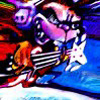 In adidition to a fourth LP side not available on the CD edition, Beta-Lactam Ring's double vinyl edition of Audiosapien also comes with a bonus 12" billed as Earthmonkey vs. Nurse With Wound. Hanu @ Basecloudis a welcome companion to the album, and could even stand on its ownquite well as a short LP. The record is introduced by the legendaryJimmy Carl Black of the Mothers of Invention, intoning his famous linewhich will be very familiar to Zappa fans: "Hi, I'm Jimmy Carl Black,I'm the Indian of the group, and you're listening to...Earthmonkey!"This auspicious introduction is sampled, spliced, chopped and pouredlike lumpy gravy over the rest of this sidelong track, a powerfullyhallucinogenic slab of fierce, majestic psych-rock that phases all overthe stereo channels. I'm guessing that Nurse With Wound's contributionlies in the incongruous vocal snippets and samples sprinkled liberallythroughout these tracks, adding just the right amount of strangenessand complexity to the primitive Kraut jams. Side B is a different beastaltogether, a Middle Eastern-textured psych excursion with a dark,shuffling beat overlaid with snaking funk guitars, horn bleats andhair-raising washes of surrealistic sound. It's a bit reminiscent ofthe soundtrack to Fantastic Planet, pulled through the other side of an hashish tent filled with ranting bedouins. This 12" is just as accomplished as Audiosapien, but with an intensity and focus that makes it even easier to return to.
In adidition to a fourth LP side not available on the CD edition, Beta-Lactam Ring's double vinyl edition of Audiosapien also comes with a bonus 12" billed as Earthmonkey vs. Nurse With Wound. Hanu @ Basecloudis a welcome companion to the album, and could even stand on its ownquite well as a short LP. The record is introduced by the legendaryJimmy Carl Black of the Mothers of Invention, intoning his famous linewhich will be very familiar to Zappa fans: "Hi, I'm Jimmy Carl Black,I'm the Indian of the group, and you're listening to...Earthmonkey!"This auspicious introduction is sampled, spliced, chopped and pouredlike lumpy gravy over the rest of this sidelong track, a powerfullyhallucinogenic slab of fierce, majestic psych-rock that phases all overthe stereo channels. I'm guessing that Nurse With Wound's contributionlies in the incongruous vocal snippets and samples sprinkled liberallythroughout these tracks, adding just the right amount of strangenessand complexity to the primitive Kraut jams. Side B is a different beastaltogether, a Middle Eastern-textured psych excursion with a dark,shuffling beat overlaid with snaking funk guitars, horn bleats andhair-raising washes of surrealistic sound. It's a bit reminiscent ofthe soundtrack to Fantastic Planet, pulled through the other side of an hashish tent filled with ranting bedouins. This 12" is just as accomplished as Audiosapien, but with an intensity and focus that makes it even easier to return to.
- Administrator
- Albums and Singles
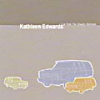 The much-hyped alt-country troubadour commemorates her long tour in support of her debut album Failerwith this short but sweet live EP/DVD. The DVD portion is just thevideos for the first two tracks on the debut, "Six O'Clock News" and"One More Song the Radio Won't Like." They're quaint, simple affairsthat really don't follow the plots of the songs but show off the manyfaces of Edwards, so the videos themselves are a bit of filler. Clipslike these are for fans only anyway, as if you didn't see it on TV andit wasn't a hit, you'll never see it again. In that regard then,they're a nice addition. The live tracks aren't filler at all,thankfully, as they really show off how Edwards can lay it on thickwhen she wants to. In promoting the record, she appeared on all thelate-night talk shows, performed the single, schmoozed it up. But theperformances themselves on the shows were lacking, honestly, as if thiswas just another in a long line of essential evils that needed to befulfilled. On the EP's tracks, recorded — obviously — at the Bowery inNew York, Edwards lets her hair down and feels the songs a bit more.And though her voice warbles a bit here and there, it's not adetraction and she still comes off as great as all the hype makes hersound. "National Steel" was my favorite track on her album, and it getsthe full treatment, frailty and all, with small changes in voice hereand there as needed. Edwards starts it off alone, but when the bandkicks in, let's just say I hope she's paying them what they deserve,cause they bring it full scale. Guitarist Colin Cripps adds great licksand capable backing vocals, too, making the songs sound darn near theirstudio counterparts in tone. "Hockey Skates" next, and it's obvious howmuch the fans love it as they cheer it on when it starts. It's looser,and Edwards lazes her way through it, but no matter as it's still agreat song. Closing out the too short experience is a clever cover ofAC/DC's "Money Talks." It shows Edwards influences, sense of humor, andability to throw a good curve. I wish the EP had been longer, but it'senough to tide fans like me over until the next awe-strikingfull-length.
The much-hyped alt-country troubadour commemorates her long tour in support of her debut album Failerwith this short but sweet live EP/DVD. The DVD portion is just thevideos for the first two tracks on the debut, "Six O'Clock News" and"One More Song the Radio Won't Like." They're quaint, simple affairsthat really don't follow the plots of the songs but show off the manyfaces of Edwards, so the videos themselves are a bit of filler. Clipslike these are for fans only anyway, as if you didn't see it on TV andit wasn't a hit, you'll never see it again. In that regard then,they're a nice addition. The live tracks aren't filler at all,thankfully, as they really show off how Edwards can lay it on thickwhen she wants to. In promoting the record, she appeared on all thelate-night talk shows, performed the single, schmoozed it up. But theperformances themselves on the shows were lacking, honestly, as if thiswas just another in a long line of essential evils that needed to befulfilled. On the EP's tracks, recorded — obviously — at the Bowery inNew York, Edwards lets her hair down and feels the songs a bit more.And though her voice warbles a bit here and there, it's not adetraction and she still comes off as great as all the hype makes hersound. "National Steel" was my favorite track on her album, and it getsthe full treatment, frailty and all, with small changes in voice hereand there as needed. Edwards starts it off alone, but when the bandkicks in, let's just say I hope she's paying them what they deserve,cause they bring it full scale. Guitarist Colin Cripps adds great licksand capable backing vocals, too, making the songs sound darn near theirstudio counterparts in tone. "Hockey Skates" next, and it's obvious howmuch the fans love it as they cheer it on when it starts. It's looser,and Edwards lazes her way through it, but no matter as it's still agreat song. Closing out the too short experience is a clever cover ofAC/DC's "Money Talks." It shows Edwards influences, sense of humor, andability to throw a good curve. I wish the EP had been longer, but it'senough to tide fans like me over until the next awe-strikingfull-length. samples:
Read More
- Administrator
- Albums and Singles
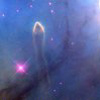
If he is mentioned at all, Martijn de Kleer is mentioned primarily for his job as twice lead guitarist and youngest member of The Legendary Pink Dots. Produced by LPD mainstay Raymond Steeg, and boasting guest appearances from drummer Cevin Key (Tear Garden, Skinny Puppy) and bassist Ryan Moore, So Close Yet So Far Out uses an impressive variety of approaches and instrumentation, by far outstripping any of the usual implications of a solo guitar album. In addition to playing some deliciously fried fuzz guitar, de Kleer also tackles bass, synthesizer, organ and some surprisingly passable vocals. What he accomplishes is a psych-rock long-player with shades of damaged 60's psychedelia, shoegazer pop, and a clear affection for the rich, textural space dementia of Hallway of the Gods-era LPD.Beta-Lactam Ring
It's no coincidence that "New" is the English equivalent of Neu!, as the song owes a debt to Rother and Dinger, a chugging organ-and-drum beat that form the perfect backdrop for de Kleer's fragile vocals and brain-sizzling guitar. "Delayed Chemistry" is propelled by de Kleer's lyric, a compact pop song boasting dense production and a ridiculously shredding guitar solo. It's a bit reminiscent of Bevis Frond's work, which is saying a lot. "Jet Lag" is a favorite, a heavy-as-shit anthemic blast of stoner metal, heavily phased and placed alongside the screaming engine of a jumbo jet. An actual White Mountain Apache storyteller narrates a mystical tale against a backdrop of de Kleer's mellow psych on "What Happened To A Young Man...," and the whole thing sounds a bit like a fantasy soundtrack to one of Jim Morrison's peyote trips. The cyclical lyrical refrain of "You Are..." is exploited to gradually lift the track into the stratosphere on an ectoplasmic crest of swirling guitar effects. "The Apple Crumble Trail" is a 25-minute meditational soundscape utilizing field recordings of Himalayan villagers, expanding into a masterpiece of slow-cooked rock splendor that gy!be and their ilk would be too cynical to produce.
samples:
Read More
- Administrator
- Albums and Singles
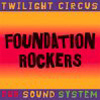 Ryan Moore's bedroom dub albums have taken him far beyond any of theacclaim and recognition of his stint as the bassist for the LegendaryPink Dots, garnering almost unanimous critical praise. Twilight CircusDub Sound System succeeds because of its deceptive simplicity; themusic seems to be an alarmingly precise and studied recreation of theoriginal, groundbreaking 1970s dub by progenitors King Tubby and LeePerry. The warm, organic textures, the unashamedly melodic basslines,the deliberately messy live instrumentation and atmposphere arecompletely without peer on the current scene, dominated byboundary-pushing German artists such as Pole and Rhythm & Sound,who often surgically excise reggae's soul in their clinical pursuit ofpost-dub experimentalism. All of Moore's albums up to this point havebeen exclusively instrumental dub, using a minimal palette to portrayhis signature sound. After eight or so albums however, this limitingformula would have become repetitive to all but the most hardcoreclassic dub fans. Foundation Rockerstakes a deliberate step into new waters — a collection of vocal dubs bya number of great Jamaican vocalists with full horn sections andtop-notch production. I am happy to report that the album is abeautiful accomplishment — a warm, wet, nuanced album that is entirelyredolent of classic dub productions, but with a creative edge thatkeeps it from becoming a retro exercise. The legendary Big Youthcontributes the de rigeur antiwar vocals on "Love Is What We Need," amellow, vibe-y song that gets even better after it's been dipped intothe Amsterdam bongwater on "Dub Is What We Need." Luciano's laments forpeace and unity float alongside Moore's gloriously rocksteady rhythmsand vibratory bassline on "What We Got To Do." "Alpha Skank" in aninstrumental track spotlighting the talents of the Might Three Hornsbrass section that lend their considerable talents to the whole album.Every track is a winner here, but Mykal Rose's particularly hauntingcrooning on "No Burial," as well as Moore's heartbreaking guitar fills,push the song to the top of the heap. Foundation Rockers is anextraordinarily lovely album of reverential dub reggae that exceedsexpectations and delivers on the promises of Moore's back catalog.
Ryan Moore's bedroom dub albums have taken him far beyond any of theacclaim and recognition of his stint as the bassist for the LegendaryPink Dots, garnering almost unanimous critical praise. Twilight CircusDub Sound System succeeds because of its deceptive simplicity; themusic seems to be an alarmingly precise and studied recreation of theoriginal, groundbreaking 1970s dub by progenitors King Tubby and LeePerry. The warm, organic textures, the unashamedly melodic basslines,the deliberately messy live instrumentation and atmposphere arecompletely without peer on the current scene, dominated byboundary-pushing German artists such as Pole and Rhythm & Sound,who often surgically excise reggae's soul in their clinical pursuit ofpost-dub experimentalism. All of Moore's albums up to this point havebeen exclusively instrumental dub, using a minimal palette to portrayhis signature sound. After eight or so albums however, this limitingformula would have become repetitive to all but the most hardcoreclassic dub fans. Foundation Rockerstakes a deliberate step into new waters — a collection of vocal dubs bya number of great Jamaican vocalists with full horn sections andtop-notch production. I am happy to report that the album is abeautiful accomplishment — a warm, wet, nuanced album that is entirelyredolent of classic dub productions, but with a creative edge thatkeeps it from becoming a retro exercise. The legendary Big Youthcontributes the de rigeur antiwar vocals on "Love Is What We Need," amellow, vibe-y song that gets even better after it's been dipped intothe Amsterdam bongwater on "Dub Is What We Need." Luciano's laments forpeace and unity float alongside Moore's gloriously rocksteady rhythmsand vibratory bassline on "What We Got To Do." "Alpha Skank" in aninstrumental track spotlighting the talents of the Might Three Hornsbrass section that lend their considerable talents to the whole album.Every track is a winner here, but Mykal Rose's particularly hauntingcrooning on "No Burial," as well as Moore's heartbreaking guitar fills,push the song to the top of the heap. Foundation Rockers is anextraordinarily lovely album of reverential dub reggae that exceedsexpectations and delivers on the promises of Moore's back catalog.Read More
- Administrator
- Albums and Singles
 Greg Davis' music is difficult to not like. If abstract computer musicis at all your thing (and it occasionally is mine), Davis' is nothingif not pleasant. It exudes a serene positiveness—an easy and smilingwarmth. The music of this disc, culled from a live radio session onVPRO in Amsterdam and featuring songs that appeared on his previouslyreleased albums and singles, appears to be grounded in folk and popsongs with the structures gently splayed into digital dots. StephanMathieu and Christian Fennesz tread along paths such as this one, butDavis' music is remarkable in that, despite the random bleeping noises,there are no sharp edges to it at all. It's inoffensive, innocuous,fading into the background just as readily as it intruiges (to thosewho wish to engage it in this manner) with the richness of itscomponent sounds. When Davis finally sings and plays acoustic guitar inthe Beach Boys cover that closes this album, I imagine him sitting withhis laptop at the bedside of a child, tucking her in and lulling her tosleep. Or else he's sitting on a swing in some lush garden on a sunnyafternoon, soaking in the sun and running some loose melodies through aMax patch. This could easily veer off into Nobukazu Takemura-likequasi-New Age drool, but somehow it remains tasteful. Only a real cyniccould not smile along with him.
Greg Davis' music is difficult to not like. If abstract computer musicis at all your thing (and it occasionally is mine), Davis' is nothingif not pleasant. It exudes a serene positiveness—an easy and smilingwarmth. The music of this disc, culled from a live radio session onVPRO in Amsterdam and featuring songs that appeared on his previouslyreleased albums and singles, appears to be grounded in folk and popsongs with the structures gently splayed into digital dots. StephanMathieu and Christian Fennesz tread along paths such as this one, butDavis' music is remarkable in that, despite the random bleeping noises,there are no sharp edges to it at all. It's inoffensive, innocuous,fading into the background just as readily as it intruiges (to thosewho wish to engage it in this manner) with the richness of itscomponent sounds. When Davis finally sings and plays acoustic guitar inthe Beach Boys cover that closes this album, I imagine him sitting withhis laptop at the bedside of a child, tucking her in and lulling her tosleep. Or else he's sitting on a swing in some lush garden on a sunnyafternoon, soaking in the sun and running some loose melodies through aMax patch. This could easily veer off into Nobukazu Takemura-likequasi-New Age drool, but somehow it remains tasteful. Only a real cyniccould not smile along with him. Read More
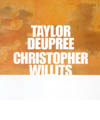 This collaboration began during a performance at Tonic in NYC celebrating the release of Willits' Folding, and the Tea,still one of my favorites on Deupree's 12k label. Willits' style ofguitar processing, a method he calls "folding," involves the digitalreassembling of plucked rhythms and melodies in a way that resists bothfragment pile-up techniques and a tired glitch aesthetic. Theaccurately "folded" results show evidence of computerized cuts, falsestops, and redirections, but each piece also retains the timbre andirregular sustain of the guitar itself, as if Willits' laptop were justanother pedal at his feet, each uncanny alteration arriving seamlessly,swift as the click of a heel. Folding would not be asimpressive, however, if the guitarist's playing were not sounderhandedly melancholic. Without the rolling minor chords of someonelike Fennesz, Willits brings emotion to his music in a more subtle way,producing fragile, staggered tonal clusters, taking on weight only asthey are creased and misaligned during the "folding" process. The "tea"to which his debut's title refers is clearly not the skyward,psychedelic brew filling fellow lap-tarist Joseph Suchy's glass, butmore like a strong herbal black, the kind meant to accompany sittingand staring into surfaces. Taylor Deupree's earthbound approach tomicro-tonal sound arrangement is a perfect match for the concentrated,tactile element of Willits' work. Fostered by the growth of his 12kimprint, Deupree's now-mature style has developed around a minimalistdissection of sound, a mapping of sound particles in a way that, likeWillits', avoids an obsession with glitch-ist process, ordeconstruction per se. Instead, Deupree, along with the expanding 12kroster, favors a highly suggestive magnification of sound events thatfeels wholly related to human gesture and the surrounding world, fullof miniature drama and plaintive tug. Most of the music on Audiosphere 08comes from live sessions where Deupree uses Willits' guitar, run firstthrough the folding box, as source material for his microsoundinvestigations. The live setup creates a kind of circular dialogueresulting in some remarkably focused compositions. Up close, theproduct of the collaboration is predictable: the dominance of Willits'guitar gives the tunes a buoyancy and a more present melodic portionthan Deupree is used to, and the latter's position in the backgroundsituates the guitar's colorful folds in a crisp stew of tiny sounds,ranging from the static skips and jumps more typical of Deupree's solooutput to assertive drones, pulsing as if stripped from the core of aplucked string. At greater remove, isolating each musician'scontribution becomes not only impossible, but a easily forgotteninterference in the enjoyment of these tracks, so much so that the twosolo live tracks also included make for an interesting look at just howmuch one of these guys brings to the table. As a release, Audioshere 08holds up surprisingly well among the intimidating previous output ofits contributors, and as a collaboration, this music is a stunningachievement, a beautiful rounded sound that leaves me hoping this duowill record again.
This collaboration began during a performance at Tonic in NYC celebrating the release of Willits' Folding, and the Tea,still one of my favorites on Deupree's 12k label. Willits' style ofguitar processing, a method he calls "folding," involves the digitalreassembling of plucked rhythms and melodies in a way that resists bothfragment pile-up techniques and a tired glitch aesthetic. Theaccurately "folded" results show evidence of computerized cuts, falsestops, and redirections, but each piece also retains the timbre andirregular sustain of the guitar itself, as if Willits' laptop were justanother pedal at his feet, each uncanny alteration arriving seamlessly,swift as the click of a heel. Folding would not be asimpressive, however, if the guitarist's playing were not sounderhandedly melancholic. Without the rolling minor chords of someonelike Fennesz, Willits brings emotion to his music in a more subtle way,producing fragile, staggered tonal clusters, taking on weight only asthey are creased and misaligned during the "folding" process. The "tea"to which his debut's title refers is clearly not the skyward,psychedelic brew filling fellow lap-tarist Joseph Suchy's glass, butmore like a strong herbal black, the kind meant to accompany sittingand staring into surfaces. Taylor Deupree's earthbound approach tomicro-tonal sound arrangement is a perfect match for the concentrated,tactile element of Willits' work. Fostered by the growth of his 12kimprint, Deupree's now-mature style has developed around a minimalistdissection of sound, a mapping of sound particles in a way that, likeWillits', avoids an obsession with glitch-ist process, ordeconstruction per se. Instead, Deupree, along with the expanding 12kroster, favors a highly suggestive magnification of sound events thatfeels wholly related to human gesture and the surrounding world, fullof miniature drama and plaintive tug. Most of the music on Audiosphere 08comes from live sessions where Deupree uses Willits' guitar, run firstthrough the folding box, as source material for his microsoundinvestigations. The live setup creates a kind of circular dialogueresulting in some remarkably focused compositions. Up close, theproduct of the collaboration is predictable: the dominance of Willits'guitar gives the tunes a buoyancy and a more present melodic portionthan Deupree is used to, and the latter's position in the backgroundsituates the guitar's colorful folds in a crisp stew of tiny sounds,ranging from the static skips and jumps more typical of Deupree's solooutput to assertive drones, pulsing as if stripped from the core of aplucked string. At greater remove, isolating each musician'scontribution becomes not only impossible, but a easily forgotteninterference in the enjoyment of these tracks, so much so that the twosolo live tracks also included make for an interesting look at just howmuch one of these guys brings to the table. As a release, Audioshere 08holds up surprisingly well among the intimidating previous output ofits contributors, and as a collaboration, this music is a stunningachievement, a beautiful rounded sound that leaves me hoping this duowill record again.samples:

